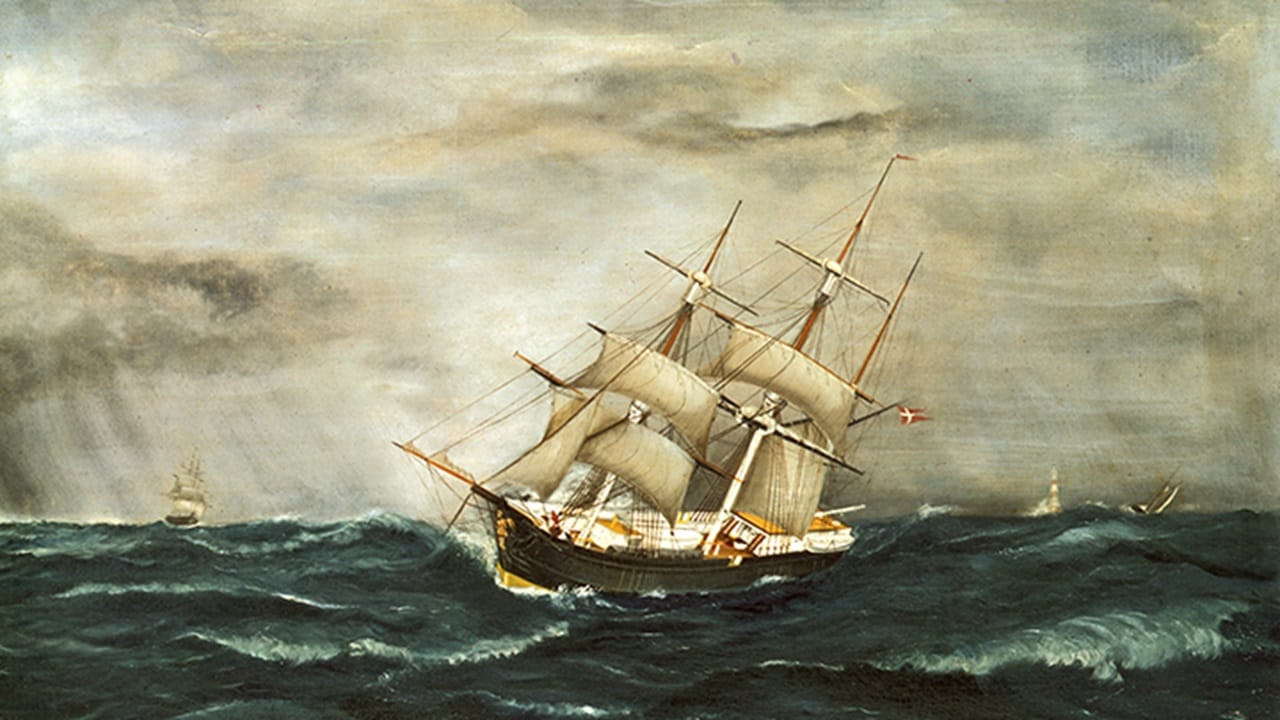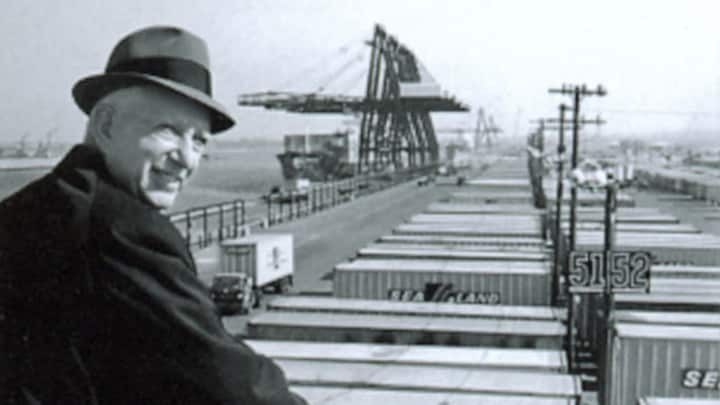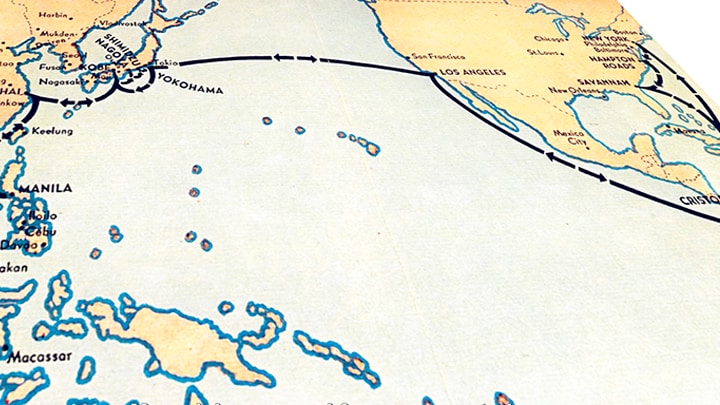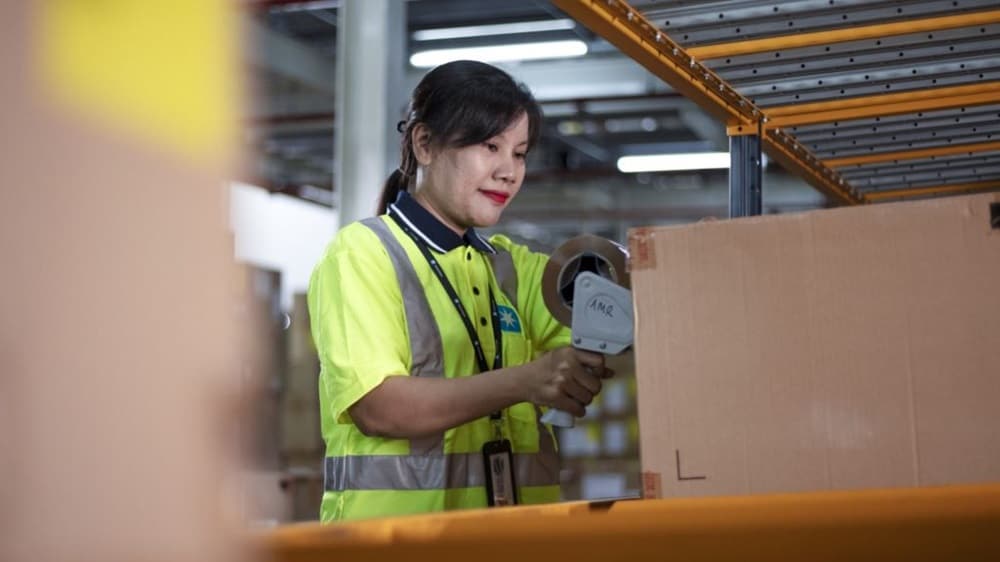
The history and heritage of A.P. Moller - Maersk
Connecting the world for more than a century.
Navigating change
Full steam ahead
Human beings have been transporting goods by sea for over 5000 years, but until the Industrial Revolution and the invention of the steam engine, we were reliant on the weather. No wind, no crossing.
With the introduction of steam power, the crew of a ship was in full control of its propulsion for the first time in human history. The invention completely revolutionised maritime transport, making new routes possible and giving trade by sea a major boost.

Bending with the wind
In 1883, when Peter Mærsk Møller’s sailing ship VALKYRIEN was wrecked, leaving him with no means of providing for his family, he found himself at an important crossroads. Thanks to the Industrial Revolution, steam power had begun to replace sail as a more reliable and predictable method of marine propulsion, but it was not yet widely used in Danish shipping.
At the age of 50, and with ten children to provide for, Peter Mærsk Møller faced a choice: stick to the sailing ships he had always known, which he believed would soon be obsolete, or invest in the future. He chose the latter, and in 1886, after completing his training to become a steamship master, he acquired the small steamer LAURA.

Revolution takes time
Although steam engines were a vast improvement on sail, they were still inefficient, and it would not be long before maritime transport was once again disrupted by the invention of the diesel engine.
Steam engines required large quantities of coal and bigger crews to keep the engines fired constantly. Diesel-powered engines, although more expensive, used less fuel, took up less space, and required less manpower to operate.
Just like marine transport itself, the transition from sail to steam, and then from steam to diesel, did not happen instantly. Revolutions in shipping take time, and it would be several decades before diesel fully replaced steam power.
Changing course
When Peter Mærsk Møller’s son, A.P. Møller, founded Maersk in 1904, steamships were the standard mode of maritime transport. But they were far from perfect.
Like his father, A.P. Møller had his sights set firmly on the future, and in 1921 Maersk purchased LEISE MÆRSK – Maersk’s first diesel-powered vessel. This acquisition, just nine years after the launch of the first ever diesel-powered ocean-going merchant vessel, made Maersk the first company to use a diesel-powered ship in tramp shipping.

A new way to trade
During the early part of the 20th century, the majority of the Danish fleet were involved in tramp shipping. Tramp ships did not operate on a fixed route or schedule, and would simply make stops in any port that had cargo available for transport. It would be the responsibility of the shipper to plan the most profitable route, depending on the type and amount of cargo they had on board.
In the years following the First World War, the emergence of liner shipping saw the establishment of fixed routes and port calls. As well as being simpler than tramp shipping, this was also a less risky way for shipowners to trade.

Seizing an opportunity
When the First World War caused the economy in Europe to grind to a halt, A.P. Møller began to consider alternatives to the tramp shipping model. Across the Atlantic the Panama Canal had opened and the US economy was booming, with more voyages departing North America to the Asian ports beyond.
However, Maersk’s first liner service was something of an experiment. Having always preferred the challenge of tramp shipping, A.P. Møller was not trained in liner shipping, and his ships were designed for the large bulk cargoes of tramp trade.
Despite these potential pitfalls, the fixed service became a great success, and Maersk’s first bespoke liner vessel – GERTRUDE MÆRSK – joined the fleet in 1930.

Tramp shipping vs liner shipping
Thinking inside the box
Liner shipping, although more financially stable, was not without complexity. The loading and unloading of both tramp and liner ships was extremely time consuming and despite the use of forklift trucks and pallets, vessels spent more time in port than at sea.
It was while Malcolm McLean, founder of Sealand, waited for his truck to be unloaded one day that he came up with an idea – what if the truck didn’t have to be unloaded at all?
McLean’s intermodal container reduced the time it took to load and unload vessels from several days, to a matter of hours. It was arguably the most radical shift the industry had ever seen.
Maersk moves to containerise
Although the first intermodal containers were shipped in 1956, it would be 17 years before customer demand was significant enough for Maersk to move into containerising our own fleet.
As containerisation became more widespread, Maersk began to receive more customer requests for containerised transport in the niche markets where we primarily operated. To keep the USA-ASIA service competitive, the decision to invest in cellular container ships, containers and equipment was made in 1973.
From container control, to shipping document management, to tables and statistics and even claims control, it was clear that new data management systems were needed, as well as better and more immediate communication between offices. The answer, once again, was to look to the future and embrace new technologies.

Dealing in data
Maersk began keeping accounts for voyages with punch card machines in 1956, moving to computers in the 1960s. As complexity increased, decisions and control relied on fast access to reliable, up-to-date information. In 1970, Maersk Data – a separate A.P. Moller Group company – was established.
Originally created to develop systems for the A.P. Moller Group companies, one of Maersk Data’s first tasks was related to Maersk’s move into containers: to find a way to move data electronically and communicate easily between offices. The MaerskNet was launched in 1975, and during the 1980s became one of the largest privately controlled communication networks. This ability to communicate globally between offices became a key competitive differentiator for Maersk.
One of the main systems on the MaerskNet was MCS – the Maersk Communication System. Introduced in 1983, MCS was an early version of what we recognise today as email, and enabled desk-to-desk communication between the growing number of Maersk offices around the world.

Maersk data - at a glance
A supply chain reaction
The standard container completely revolutionised shipping and logistics. It was now possible to move cargo from ships, to trains, to trucks, and back again without ever disturbing the goods inside.
And yet, while the container enables inland transport and cargo consolidation, it is merely the visible tip of a colossal iceberg: the supply chain.
While the phrase “supply chain management” was first coined in 1982, it would be ten years before the digital systems necessary to support the concept were available. Although less visible, and perhaps less iconic than the container, hidden enablers like the barcode and the internet helped to make supply chains a reality. And they’re still central to the way world trade operates today.

New possibilities
Advances in ocean transport and the invention of the container helped to make globalisation physically possible. Geopolitical events and international agreements like the General Agreement on Tariffs and Trade (GATT), introduced after the Second World War, helped to make it politically possible.
In the years after the fall of the Berlin Wall in 1989, this process gathered speed, and new trade routes opened all over the world. Companies with headquarters in one country could have their production facilities elsewhere and sell their products in all markets. In the decade that followed, trade became truly global.
There’s little doubt that globalisation has played a huge role in Maersk becoming the global integrator of logistics that we are today. But it’s also true that the phenomenal explosion of global trade over the last century wouldn’t have been possible without incredible feats of engineering and technological ingenuity across the entire transport and logistics sector.
Trade grows, Maersk grows with it
As global trade was expanding exponentially, so was Maersk. In 1990, Maersk had offices in 40 countries. By 2000, we were in over 100 countries worldwide, opening new offices in six countries per year on average during the 1990s.
But it wasn’t just the business that was expanding to meet the growing global demand – our ships were too. Maersk’s first fully built container vessel, delivered in 1974, could carry around 1,800 20ft containers. The latest generation of Maersk Triple E vessels, delivered in 2017, can carry over 19,000 20ft containers.

Maersk growth - at a glance
Keeping the world connected
The world as we know it today is deeply reliant on global supply chains. From the banana farmer in Colombia, to the Danish child peeling a banana for their lunch, supply chains keep the world connected.
As the world grapples with the climate emergency, the future of these supply chains and indeed global trade rests on the ability to reach climate neutral.


Our commitment to a greener future
With the order of the first methanol enabled vessel in 2021, and the launch of the world’s first carbon-neutral liner vessel in 2023, Maersk is now standing at the forefront of yet another revolution.
Our mission to decarbonise our fleet is already well underway, and we’ve set a target to reach net zero across all of Maersk by 2040.





